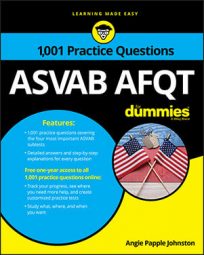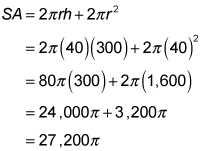Practice questions
- How much sheet metal is necessary to create a cylinder-shaped water tank that is 300 feet long and has a diameter of 80 feet?
A. 85,408 sq. ft. B. 85,408 cu. ft. C. 84,016 sq. ft. D. 82,971 sq. ft.
- Sergeant First Class Aziz ordered his troops to fill four rectangular boxes with sand to hold down the flight line. If each box is 2.5 feet wide, 1 foot high, and 2 feet long, how many cubic feet of sand will the soldiers put into the boxes altogether?
A. 20 cu. ft. B. 22 cu. ft. C. 5 cu. ft. D. 18.5 cu. ft.
Answers and explanations
- The correct answer is Choice (A).
This question is asking you for the surface area of the water tank. Don't forget that the cylinder has two ends as well. You can find the surface area of a right cylinder with the formula
where SA represents the surface area and r represents the radius. Fill in the variables with what you know and solve:
Pi is approximately equal to 3.14, so to find the answer, multiply 27,200 by 3.14:
The surface area of this massive cylinder is approximately 85,408 square feet.
(In the military, you'll hear the expression, "It's good enough for government work!" That means you're close enough to the right answer, and on the ASVAB, 3.14 is good enough for pi. However, it can't hurt to learn that pi is also approximately equal to 22/7.)
- The correct answer is Choice (A).
The problem deals with the volume of rectangular prisms. To find the volume, use V = lwh, where V represents the volume, l represents the length, w represents the width, and h represents the height.
Each box holds 5 cubic feet of sand, but there are four boxes. Multiply 5 by 4 to find that the soldiers will have to put 20 cubic feet of sand into the boxes.


